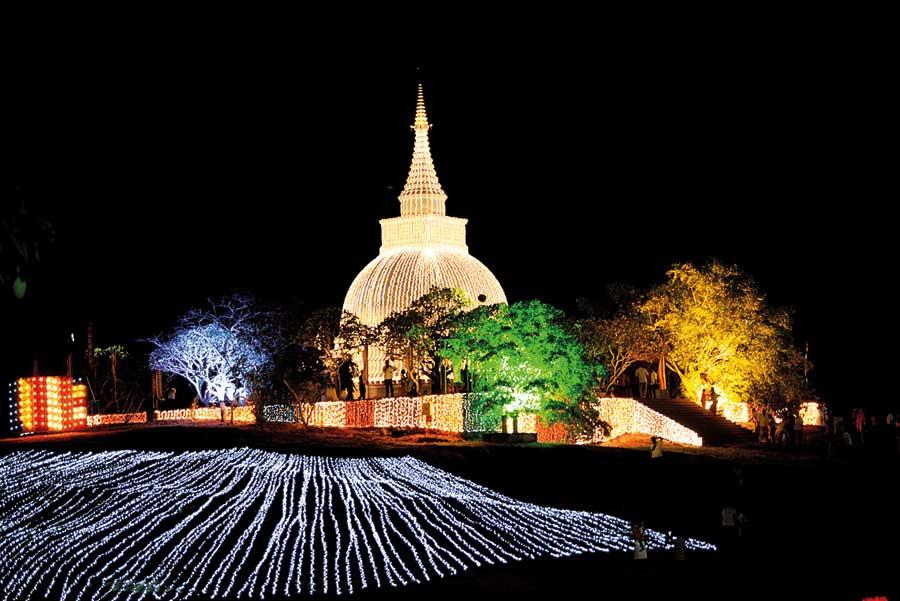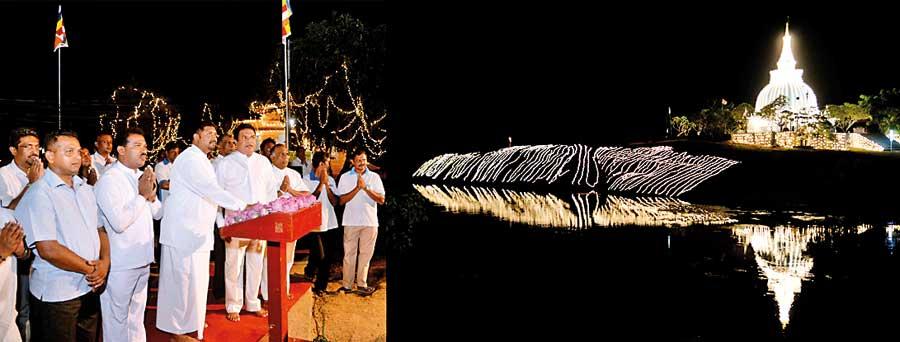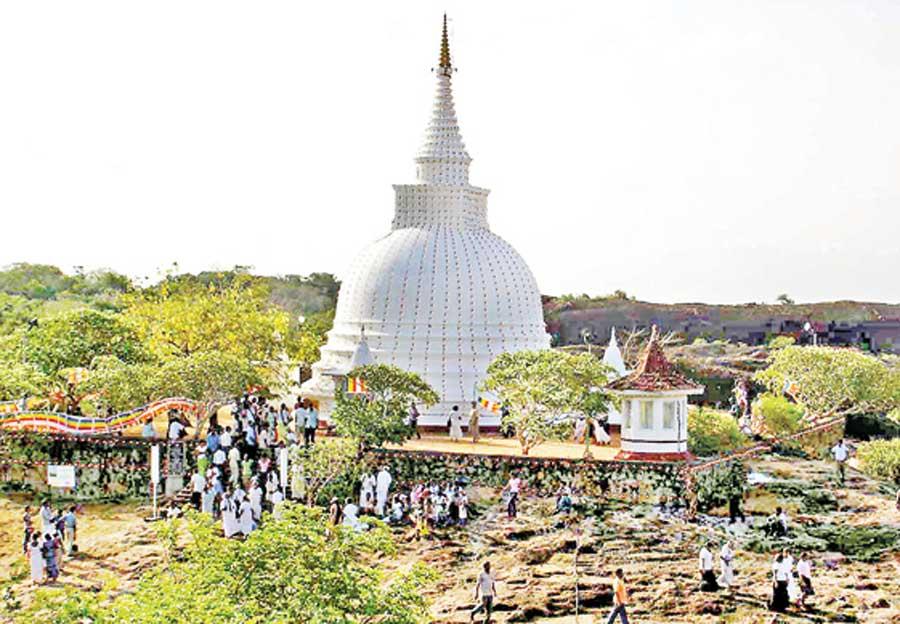18 Jun 2024 - {{hitsCtrl.values.hits}}

Wijeya Newspapers Ltd has continued to offer ‘light’ to the Thanthrimale Raja Maha Viharaya and its precinct every Poson Poya day
| The practice of doing the aloka pooja continued even during the darkest times experienced by this country; which was the civil war |
| This act will keep Thanthirimale illuminated as devotees throng the temple area on Poson Poya day to pray, meditate and reflect on Buddha’s teachings |

Sri Lanka is a country where the 12 poyas remind us that Buddhist practices must continue despite changing times. Right now the islanders are getting ready to celebrate poson poya which falls on the 21st in the month of June.
In the religious ritual of marking Poson Poya, Wijeya Newspaper Ltd has continued a staunch practice of illuminating the temple area of one of Thanthirimale’s most worshipped Buddhist places of worship which is the Thanthrimale Raja Maha Viharaya. The temple is situated about 30 miles away from Anuradhapura and sits in the pictures valley of Malwathuoya.
This year marks the 21st occasion where Wijeya Newspapers Ltd is celebrating Poson Poya by illuminating the temple area with lights. Organizers and devotees who dedicate their time for the event fondly call the event ‘aloka pooja’. The term ‘aloka pooja’ translated into English means ‘offering of lights’.
The practice of doing the aloka pooja continued even during the darkest times experienced by this country; which was the civil war. There are accounts of villagers hearing the sound of gunfire and bombs while religious practices continued in the temple precinct. The aloka pooja began in 2004, but the temple area came under the attack of terrorists in 1992. The result was severe damage to the temple. The chief prelate of the temple at that time was one among many casualties in the terror attack. But the organizer of this religious event was dogged and insisted that the practice had to continue. And so it has for many years despite changing times and encountering great difficulties.
Thanthirimale has a history of being in the Sri Lankan map even before Buddhism arrived in this country. The place is historically associated with Sangamiththa Theranee bringing the revered ‘Bo Tree’ sapling to Sri Lanka. The place is also known as the landing point of Sangamiththa Theranee when she arrived here from India.
The recorded history of Thanthirimale began in 3rd Century BC. According to Buddhist literature, King Dewanam Piyatissa- under the directions of Arahant Mahinda Thera- identified Thanthirimale as one of the places ‘touched upon’ by Gautama Buddha during the three visits by the Enlightened One to Sri Lanka. As the years rolled by, and during the ‘Polonnaruwa period’, Thanthirimale was one of the most popular places of worship in Sri Lanka. This revered place of worship has stood the tests of time. Before the Tiger rebels went on their devastating spree there was an invasion by the Kalinga Magha from the Kingdom of Kalinga in 1215. The result of the invasion was the ousting of King Parakrama Pandyan Two. Many places of worship in Polonnaruwa were damaged and also was Thanthirimale.

Ruwan Wijewardene former State Minister and currently the Senior advisor to President Ranil Wickremesinghe on Climate Change (Third from left) present at the aloka pooja in Thanthirimale (File Photo)
 In the religious ritual of marking Poson Poya, Wijeya Newspaper Ltd has continued a staunch practice of illuminating the temple area of one of Thanthirimale’s most worshipped Buddhist places of worship which is the Thanthrimale Raja Maha Viharaya
In the religious ritual of marking Poson Poya, Wijeya Newspaper Ltd has continued a staunch practice of illuminating the temple area of one of Thanthirimale’s most worshipped Buddhist places of worship which is the Thanthrimale Raja Maha Viharaya
In years afterwards, Thanthirimale Raja Maha Viharaya was fully renovated by King Parakramabahu. This is the Buddhist culture and practice in Sri Lanka. Buddhism, the temple and priests are closely associated with the people of the village. It’s the villagers who look into the interests and needs of the temple on a day-to-day basis. But historic occasions like the poya day celebrations need big support. Hence there are opportunities a plenty to get involved in meritorious activities come poya day. We cannot forget the fact that such religious occasions, in a country like Sri Lanka, have the potential to entice Buddhists and non-Buddhists alike. The involvement of Wijeya Newspapers with a religious activity in the magnitude as marking poson poya doesn’t come as a surprise. This is a media organization involved in many other religious activities as well and has been associated with Buddhism and the temple for several generations.
Buddhism is more a philosophy than a religion which offers light to people who spend their lives in the ‘dark’. This philosophy teaches its practitioners that offerings made to the temple (or Buddhist order) bring the highest meritorious benefits for the layman. And what a lovely gesture by Wijeya Newspapers Ltd to offer ‘light’ to the temple and its precinct. This act will keep this place of worship illuminated as devotees throng the temple area on this full mooned Poson Poya day to pray, meditate and reflect on Buddha’s teachings.
One of the great attractions of the place is the Buddha stature which is portrayed in a manner where the Enlightened One is in ‘samadhi’-a state of deep concentration. Another attraction is the ‘Makara Thorana’ in front of this Buddha statue. Structures like these go on to show the craftsmanship of the sculptures and artists in this island who set foot in temples to find commissioned work. Folklore tells us that some of these artwork and sculptures done in temples were left unsigned by the ‘artist’. This was because the artist was also close to reaching enlightenment or was enlightened himself; hence the non-signing of work due to the absence or killing of the ego within. Artists of yonder were great spiritual practitioners themselves and engaged in art to please or cater to the needs of the society. They didn’t demand or crave for recognition.
In the olden days, poya and the full moon served as time indicators in the absence of the calendar. Now Poya is restricted to being a day dedicated to religious worship. As time passed by and art evolved, even the colours used in temple drawings were subject to change. Brighter colours came into use in art as a result. Then we saw coloured bulbs replacing white bulbs; which were the norm in temple pandols put up on poya day. The aloka pooja at Thanthirimale- come poya day- is sure to be as colourful as in past years. This display of ‘lights’ showcases the dedication of Buddhists to the teachings of the Enlightened One. The lights illuminating Thanthirimale symbolise the fact that the practitioners of Buddhism are on the path from darkness to light. Literature associated with this event tells us that the arrival of devotees to Thanthirimale has increased since this practice of doing aloka pooja at this place of worship was begun by Wijeya Newspapers Ltd.

Thanthirimale Raja Maha Viharaya
28 Dec 2024 59 minute ago
28 Dec 2024 1 hours ago
28 Dec 2024 2 hours ago
28 Dec 2024 3 hours ago